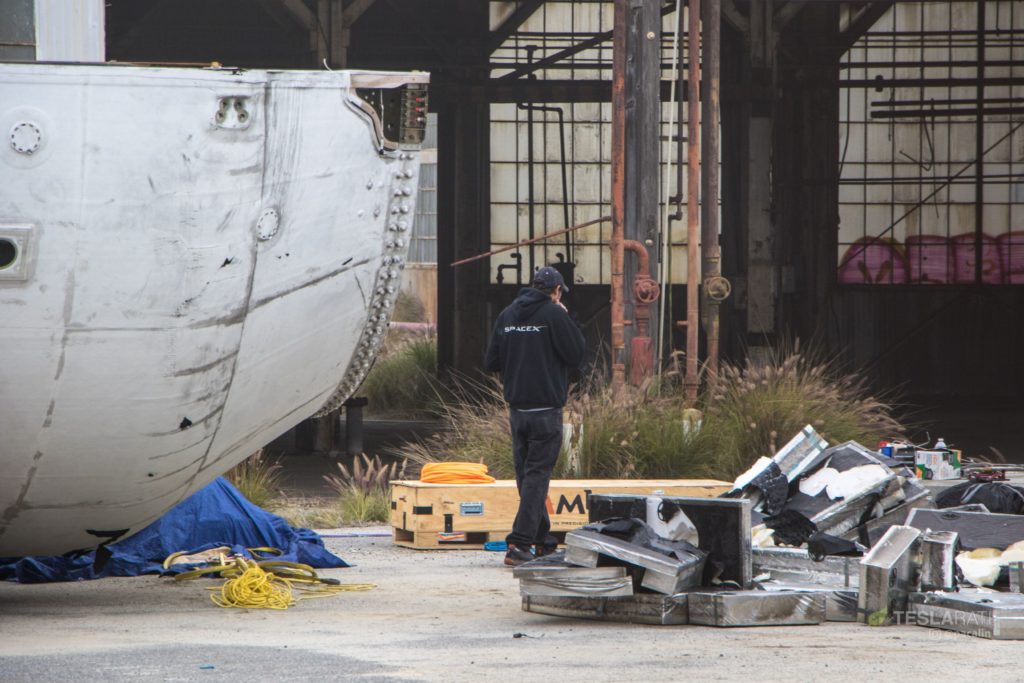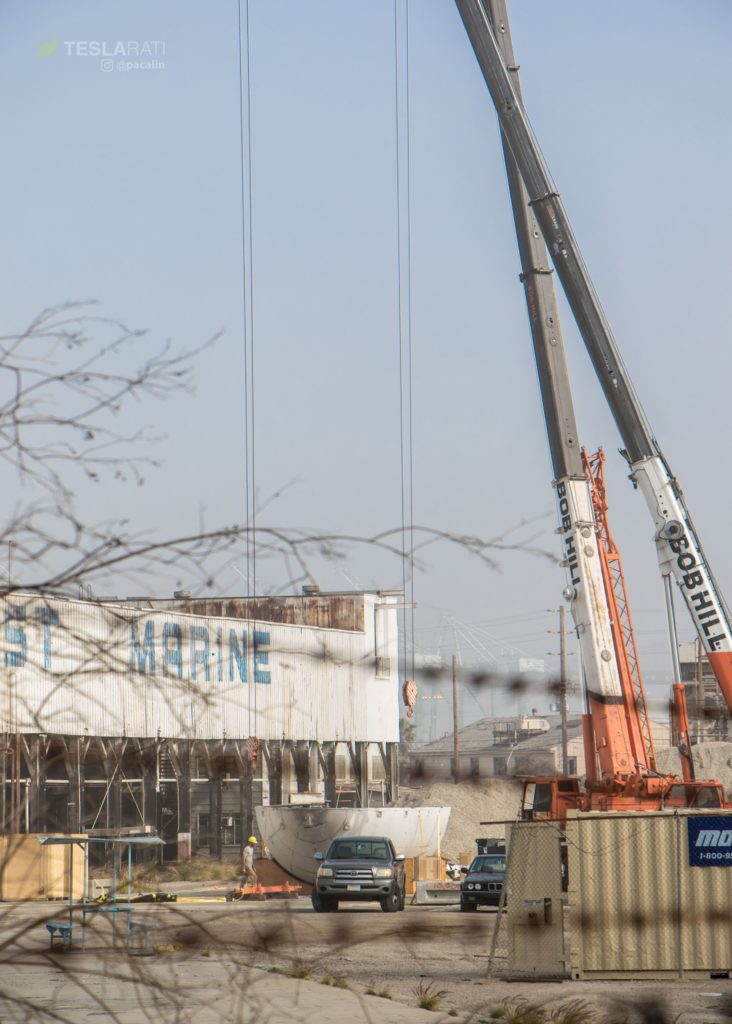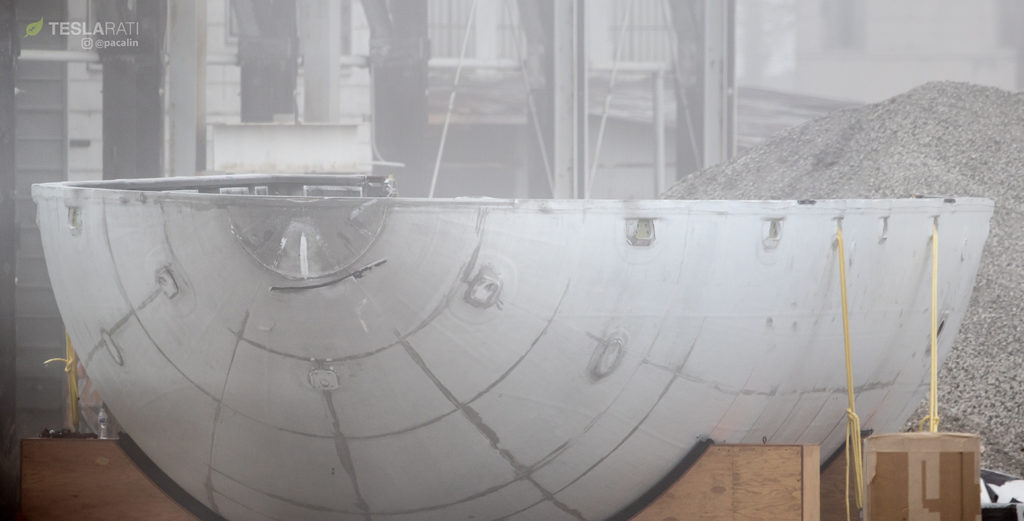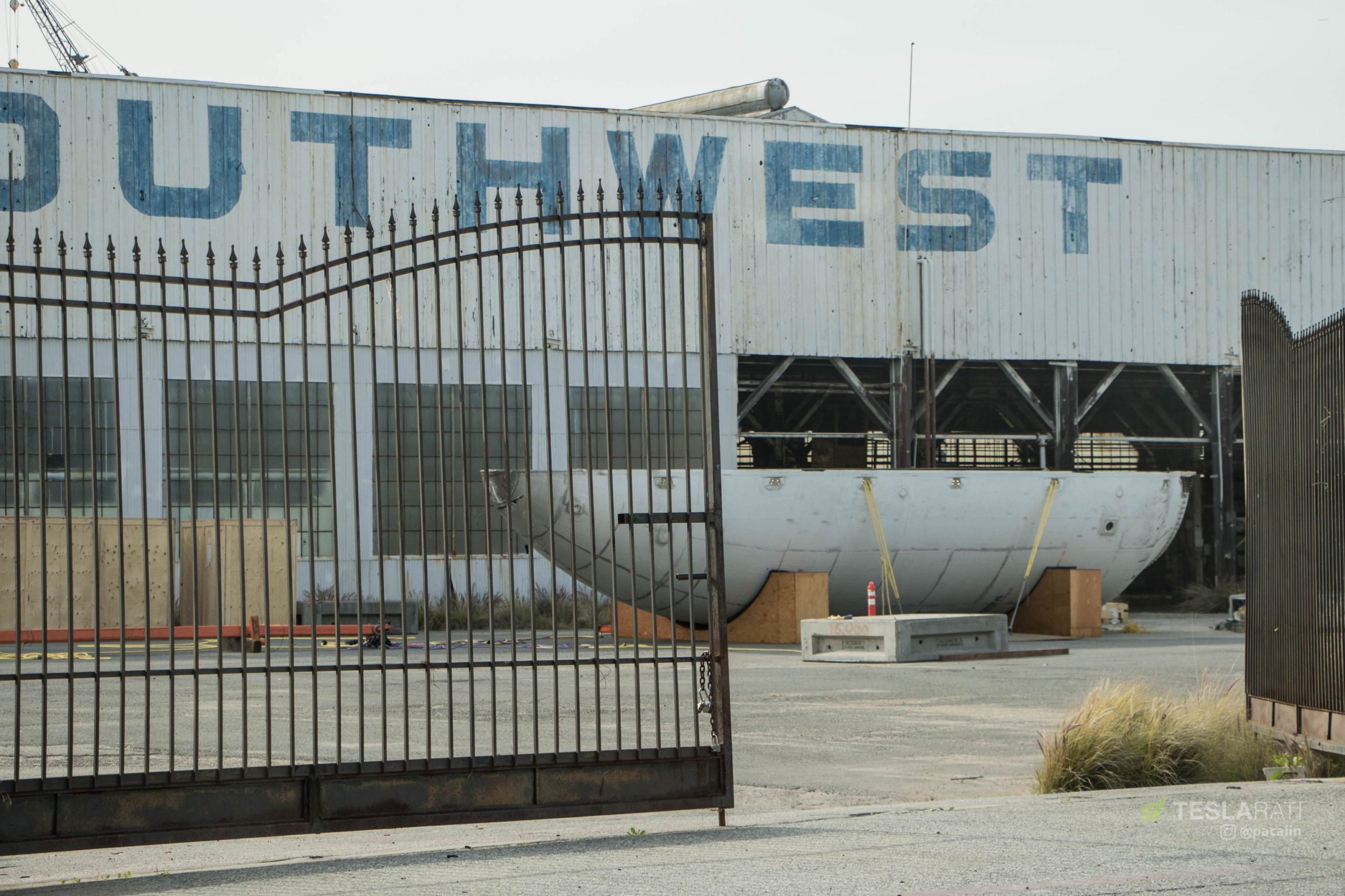
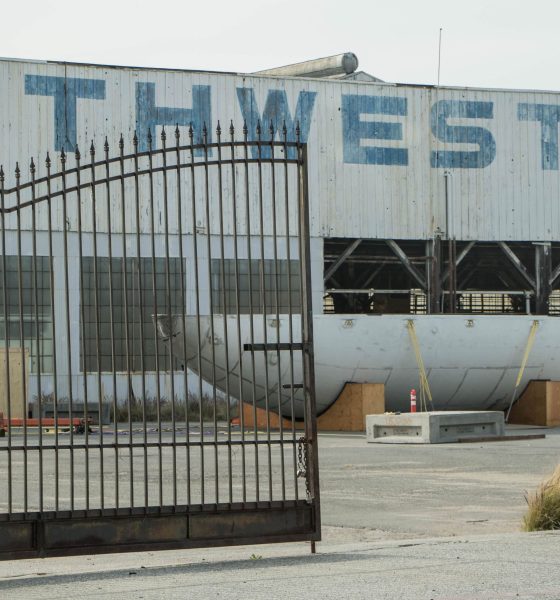
News
SpaceX recovered fairing appears at future Mars rocket factory in LA
In an unexpected turn of events, the first fairing half recovered by SpaceX – just after the Feb. 22 launch of PAZ – appeared at the company’s just-leased facilities at LA’s Port of San Pedro, also known as Berth 240 or SpaceX’s preferred location for the first BFR (Mars rocket) factory.
If there was any doubt before that SpaceX was not serious about the Port proposal released in March, or that individuals with SpaceX shirts at 240 were a mere coincidence, the arrival of an entire fairing half and two fairly large cranes ought to confirm the reality of the company’s active presence at the facility. After heading down to the port at dawn to capture Mr Steven’s arrival post-launch (providing a fairing surprise of its own), Teslarati photographer Pauline Acalin made a quick detour to Berth 240 to check up on any potential activity at the SpaceX-leased site.
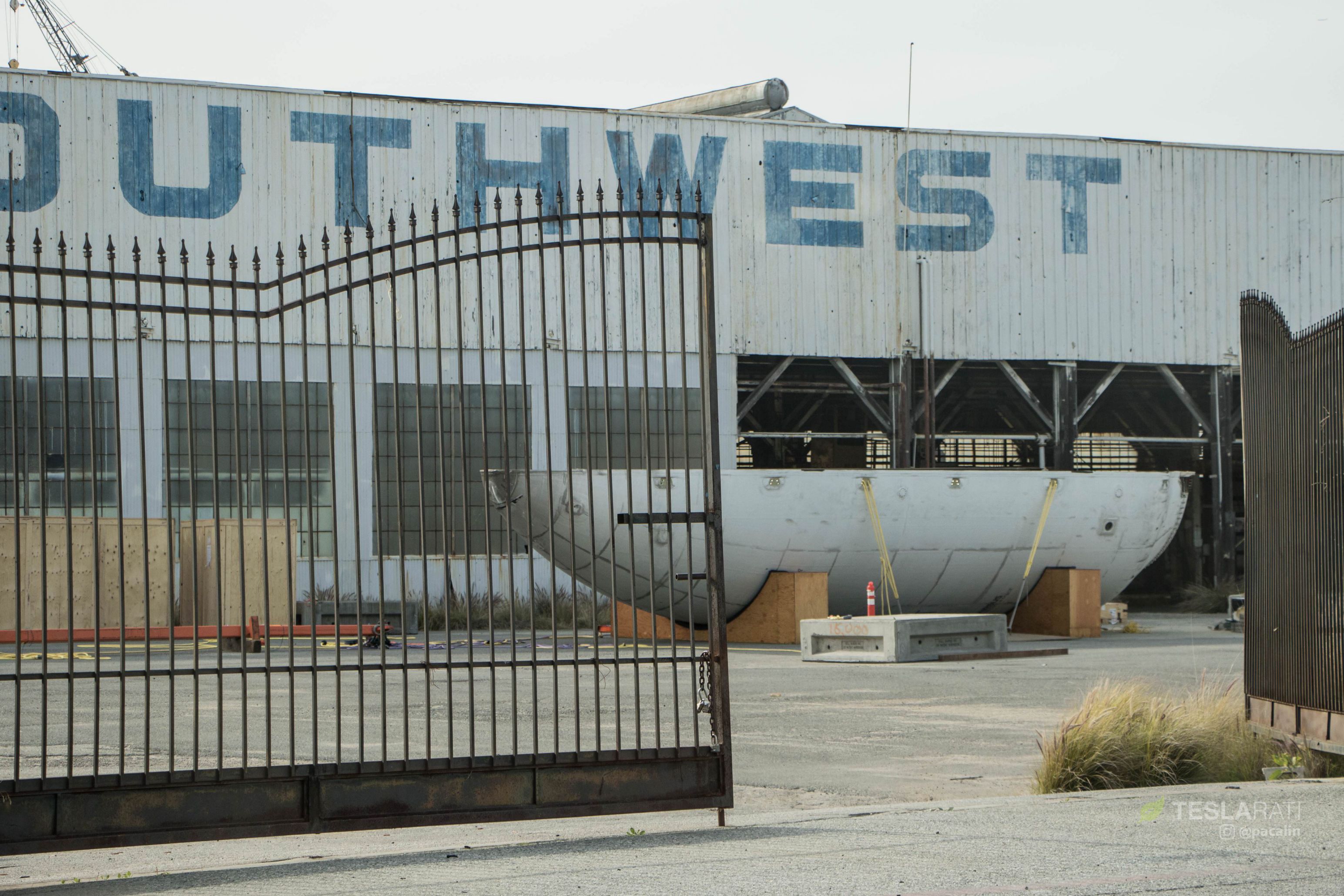
SpaceX’s first recovered fairing spotted at the BFR factory (Pauline Acalin)
Lo and behold, she found a lone recovered fairing half sitting just off the side of the public Port access road, behind the plot’s fenced enclosure. A giant Z (a la PAZ) on the fairing’s face identified it beyond any doubt to be the half that soft-landed intact just over a month ago. For such a unique pathfinder as the first apparently intact fairing half to be recovered, its uncovered storage out in the open dockside air tells us a fair bit about the reality of its condition: while it’s still surprising that this half did not spend more time (perhaps no time at all) in SpaceX’s Hawthorne facilities, this almost guarantees that the fairing suffered some form of catastrophic and irreparable damage at some point during its recovery.
- PAZ’ fairing half in all its sooty, damaged glory. (Pauline Acalin)
RIP fairing half
If this fairing were in a flightworthy state, it would undoubtedly be safely stowed inside SpaceX’s Hawthorne facilities for many weeks or even months of careful testing and analysis to properly characterize the condition of the first fairing to be recovered in one piece.
Another possibility: perhaps SpaceX has already managed that characterization and refinement through the many different fairing fragments recovered during past (unsuccessful) attempts. Ultimately, it should come as little surprise that the fairing wound up damaged – the range of conditions it was subjected to boggle the mind. Its damage may have come from post-recovery handling, perhaps something as simple as the surface tension of seawater or some water intrusion inflating its density and overloading the fairing’s structure while it was craned or dragged aboard Mr. Steven. Its loss would appear to confirm that Mr. Steven’s seemingly elaborate net system exists for very specific and technical reasons, instead of, say, a group of engineers realizing that they could convince their managers to let them build a giant claw-boat. Sometimes the crazy solution can be the right solution!
- A closeup of the landed fairing. This particularly fairing is the first flight of Fairing 2.0, a recent upgrade. (Elon Musk)
- The first fairing to ever return to land intact proudly sails into Port of San Pedro aboard Mr Steven. (Pauline Acalin)
Either way, SpaceX technicians have unequivocally begun to tear down the PAZ half’s many interior components, ranging from baffles and soundproofing panels to parafoil connectors and cold-gas maneuvering thrusters. It’s conceivable that some of those parts can be reused on future missions, partly thanks to the fact that this half remained intact after landing, keeping its interior mostly dry. Given the sheer size of the cranes brought on-site on Saturday (March 31), it seems implausible that they are there just for PAZ’ fairing – more likely, they have been rented or purchased by SpaceX and will be used for a variety of tasks related to the demolition and construction outlined in the Port’s Berth 240 lease and use-case approval.
This is almost certainly the first time that SpaceX’s Berth 240 has hosted real rocket hardware, and hopefully foreshadows a bright and busy future of reusable rocket recovery, refurbishment, and manufacturing (hopefully with BFR!).
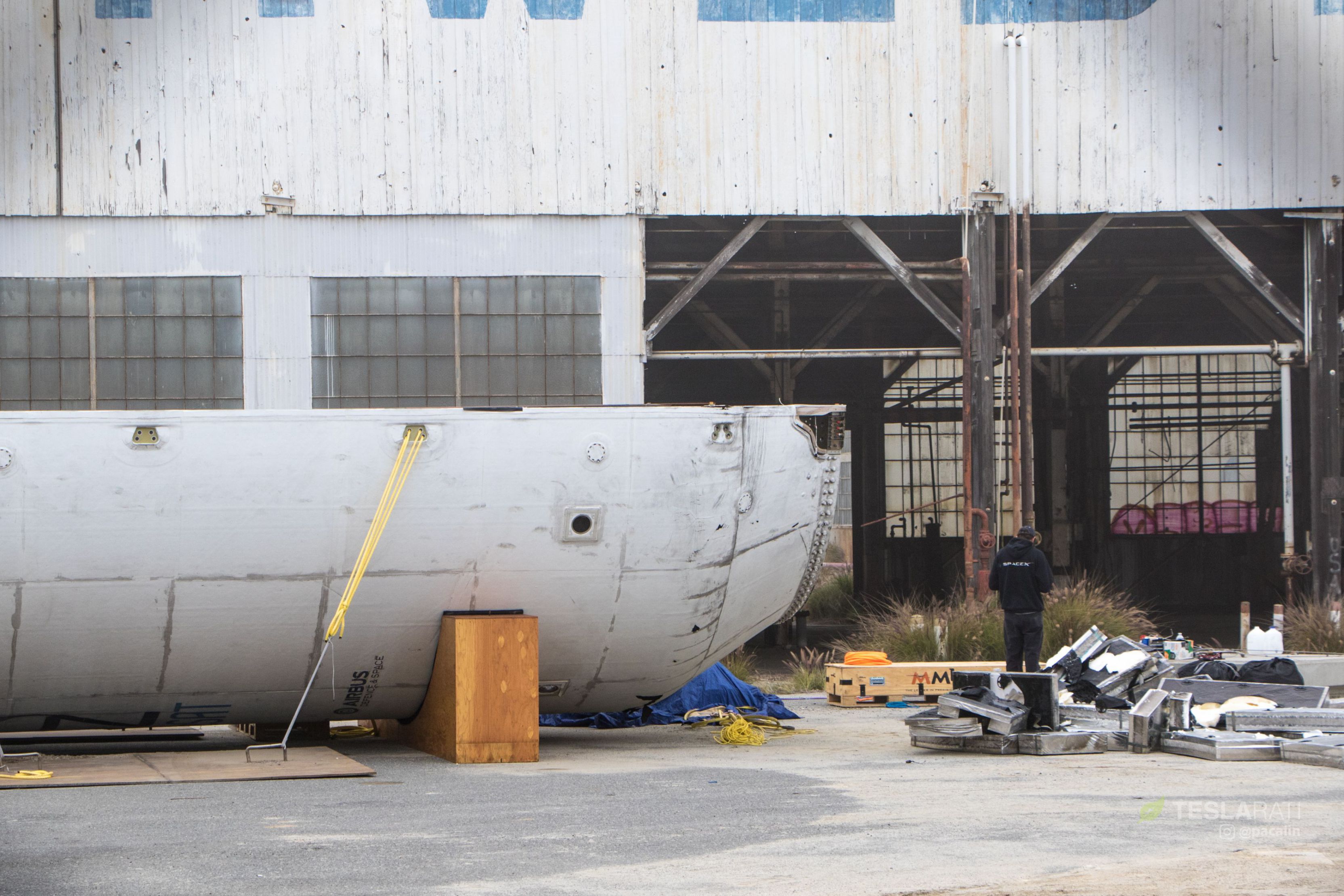
NBD, just scrapping a fairing in an abandoned shipyard. (Pauline Acalin)
Follow us for live updates, behind-the-scenes sneak peeks, and a sea of beautiful photos from our East and West coast photographers.
Teslarati – Instagram – Twitter
Tom Cross – Twitter
Pauline Acalin – Twitter
Eric Ralph – Twitter

News
Tesla FSD fleet is nearing 7 billion total miles, including 2.5 billion city miles
As can be seen on Tesla’s official FSD webpage, vehicles equipped with the system have now navigated over 6.99 billion miles.

Tesla’s Full Self-Driving (Supervised) fleet is closing in on almost 7 billion total miles driven, as per data posted by the company on its official FSD webpage.
These figures hint at the massive scale of data fueling Tesla’s rapid FSD improvements, which have been quite notable as of late.
FSD mileage milestones
As can be seen on Tesla’s official FSD webpage, vehicles equipped with the system have now navigated over 6.99 billion miles. Tesla owner and avid FSD tester Whole Mars Catalog also shared a screenshot indicating that from the nearly 7 billion miles traveled by the FSD fleet, more than 2.5 billion miles were driven inside cities.
City miles are particularly valuable for complex urban scenarios like unprotected turns, pedestrian interactions, and traffic lights. This is also the difference-maker for FSD, as only complex solutions, such as Waymo’s self-driving taxis, operate similarly on inner-city streets. And even then, incidents such as the San Francisco blackouts have proven challenging for sensor-rich vehicles like Waymos.
Tesla’s data edge
Tesla has a number of advantages in the autonomous vehicle sector, one of which is the size of its fleet and the number of vehicles training FSD on real-world roads. Tesla’s nearly 7 billion FSD miles then allow the company to roll out updates that make its vehicles behave like they are being driven by experienced drivers, even if they are operating on their own.
So notable are Tesla’s improvements to FSD that NVIDIA Director of Robotics Jim Fan, after experiencing FSD v14, noted that the system is the first AI that passes what he described as a “Physical Turing Test.”
“Despite knowing exactly how robot learning works, I still find it magical watching the steering wheel turn by itself. First it feels surreal, next it becomes routine. Then, like the smartphone, taking it away actively hurts. This is how humanity gets rewired and glued to god-like technologies,” Fan wrote in a post on X.
News
Tesla starts showing how FSD will change lives in Europe
Local officials tested the system on narrow country roads and were impressed by FSD’s smooth, human-like driving, with some calling the service a game-changer for everyday life in areas that are far from urban centers.

Tesla has launched Europe’s first public shuttle service using Full Self-Driving (Supervised) in the rural Eifelkreis Bitburg-Prüm region of Germany, demonstrating how the technology can restore independence and mobility for people who struggle with limited transport options.
Local officials tested the system on narrow country roads and were impressed by FSD’s smooth, human-like driving, with some calling the service a game-changer for everyday life in areas that are far from urban centers.
Officials see real impact on rural residents
Arzfeld Mayor Johannes Kuhl and District Administrator Andreas Kruppert personally tested the Tesla shuttle service. This allowed them to see just how well FSD navigated winding lanes and rural roads confidently. Kruppert said, “Autonomous driving sounds like science fiction to many, but we simply see here that it works totally well in rural regions too.” Kuhl, for his part, also noted that FSD “feels like a very experienced driver.”
The pilot complements the area’s “Citizen Bus” program, which provides on-demand rides for elderly residents who can no longer drive themselves. Tesla Europe shared a video of a demonstration of the service, highlighting how FSD gives people their freedom back, even in places where public transport is not as prevalent.
What the Ministry for Economic Affairs and Transport says
Rhineland-Palatinate’s Minister Daniela Schmitt supported the project, praising the collaboration that made this “first of its kind in Europe” possible. As per the ministry, the rural rollout for the service shows FSD’s potential beyond major cities, and it delivers tangible benefits like grocery runs, doctor visits, and social connections for isolated residents.
“Reliable and flexible mobility is especially vital in rural areas. With the launch of a shuttle service using self-driving vehicles (FSD supervised) by Tesla in the Eifelkreis Bitburg-Prüm, an innovative pilot project is now getting underway that complements local community bus services. It is the first project of its kind in Europe.
“The result is a real gain for rural mobility: greater accessibility, more flexibility and tangible benefits for everyday life. A strong signal for innovation, cooperation and future-oriented mobility beyond urban centers,” the ministry wrote in a LinkedIn post.
News
Tesla China quietly posts Robotaxi-related job listing
Tesla China is currently seeking a Low Voltage Electrical Engineer to work on circuit board design for the company’s autonomous vehicles.

Tesla has posted a new job listing in Shanghai explicitly tied to its Robotaxi program, fueling speculation that the company is preparing to launch its dedicated autonomous ride-hailing service in China.
As noted in the listing, Tesla China is currently seeking a Low Voltage Electrical Engineer to work on circuit board design for the company’s autonomous vehicles.
Robotaxi-specific role
The listing, which was shared on social media platform X by industry watcher @tslaming, suggested that Tesla China is looking to fill the role urgently. The job listing itself specifically mentions that the person hired for the role will be working on the Low Voltage Hardware team, which would design the circuit boards that would serve as the nervous system of the Robotaxi.
Key tasks for the role, as indicated in the job listing, include collaboration with PCB layout, firmware, mechanical, program management, and validation teams, among other responsibilities. The role is based in Shanghai.
China Robotaxi launch
China represents a massive potential market for robotaxis, with its dense urban centers and supportive policies in select cities. Tesla has limited permission to roll out FSD in the country, though despite this, its vehicles have been hailed as among the best in the market when it comes to autonomous features. So far, at least, it appears that China supports Tesla’s FSD and Robotaxi rollout.
This was hinted at in November, when Tesla brought the Cybercab to the 8th China International Import Expo (CIIE) in Shanghai, marking the first time that the autonomous two-seater was brought to the Asia-Pacific region. The vehicle, despite not having a release date in China, received a significant amount of interest among the event’s attendees.
